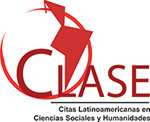Community Tourism Organization in the Parish Of Settlement, Cantón Riobamba
DOI:
https://doi.org/10.23857/dc.v10i2.3911Palabras clave:
Organization, community tourism, natural heritage, cultural heritageResumen
The research was conducted to understand why the Flores settlement has not developed community tourism, despite its significant natural and cultural attractions, such as the "Sisay Pacha" carnival, festivals, rituals, astronomy, and activities like green baskets. The settlement faces issues with poor organization of community tourism, underutilization of its heritage, and insufficient tourist services, limiting its growth. The study aims to identify the causes of this situation and propose solutions to strengthen community tourism.
The research addresses the problem, the formulation of the problem, the justifications, the objectives, and the hypotheses. It presents a theoretical framework that includes background, theoretical bases, philosophical framework, and state of the art. It describes the methodology used, detailing the type and design of the research, the unit of analysis, the study population, the sample size and selection, the operationalization of variables, the consistency matrix, the research techniques and instruments, as well as the validity and reliability of these instruments, and the analysis and presentation of the information. It focuses on the results and discussion, covering the analysis, interpretation, hypothesis testing, conclusions, and recommendations. Finally, it presents the design of the Food and Beverage Production Management Process under the guidelines of the ISO 9001-2015 standard for the Flores parish.
These findings reveal that the main obstacles to the development of community tourism in Flores are the lack of organization and training, poor destination promotion, deficient infrastructure, and limited tourist services. It is recommended to strengthen community organization, train local actors, promote the destination, improve infrastructure, and expand the range of services. The adoption of the ISO 9001-2015 standard is proposed to improve the quality of tourist services and the competitiveness of the destination.
Citas
Etzioni, I. (1965). Organizaciones Modernas. México: Uteha, México: Uteha.
Porter, L., Lawler, E., & Hackman, R. (1975). Behavior in organizations. New York: McGrawHill.
Ferrell, O., Hirt, G., Ramos, L., Adriaenséns, M., & Flores, M. (2004). Introducción a los Negocios en un Mundo Cambiante. Mc Graw-Hill Interamericana.
Smith, R. (1993). Drama bajo el manto amazónico. Ecuador: Abya Yala.
FEPTCE. (2002). Estatuto de la Federación Plurinacional de Turismo Comunitario del Ecuador. Quito: Ministerio de Turismo del Ecuador.
Beeton, S. (2006). Community development through. Landlinks Press.
Andrade, D. (31 de julio de 2019). Gestión y Desarrollo del turismo de Aventura en el cantón Riobamba, provincia de Chimborazo. Obtenido de Gestión y Desarrollo del turismo de Aventura en el cantón Riobamba, provincia de Chimborazo. http://dspace.unach.edu.ec/handle/51000/5903
García, N., & Doumet, N. (junio de 2017). El producto turístico comunitario como estrategia para diversificar las economías locales del cantón Bolívar, provincia de Manabí, Ecuador. Obtenido de El producto turístico comunitario como estrategia para diversificar las economías locales del cantón Bolívar, provincia de Manabí, Ecuador: https://dx.doi.org/10.4067/S0718-235X2017000100105
Palomino, B., Gasca, J., & Lopez, G. (21 de abril de 2015). El turismo comunitario en la Sierra Norte de Oaxaca: perspectiva desde las instituciones y la gobernanza en territorios indígenas. Obtenido de http://www.scielo.org.mx/pdf/eps/n30/1870-9036-eps-30- 00006.pdf
García, F., Pin, R., & Hechavarría, J. (2020). Rural Tourism Development Proposal. Case Study: The Commune El Palmar, Santa Elena Canton, Ecuador. Obtenido de Rural Tourism Development Proposal. Case Study: The Commune El Palmar, Santa Elena Canton, Ecuador.
Mullo, E., Vera, V., & Guillén, S. (2019). El desarrollo del turismo comunitario en Ecuador: reflexiones necesarias. Obtenido de El desarrollo del turismo comunitario en Ecuador: reflexiones necesarias: https://rus.ucf.edu.cu/index.php/rus/article/view/1175
Cabanilla, E. (2018). Turismo comunitario en América Latina, un concepto en construcción. Obtenido de Turismo comunitario en América Latina, un concepto en construcción: https://doi.org/10.29166/siembra.v5i1.1433
García, C. (2017). Empoderamiento, mujeres indígenas y turismo comunitario en Cotacachi. Obtenido de Empoderamiento, mujeres indígenas y turismo comunitario en Cotacachi: pasosonline.org/Publicados/pasosoedita/PSEdita18.pdf#page=164.
Descargas
Publicado
Cómo citar
Número
Sección
Licencia
Derechos de autor 2024 Priscila Carolina Montufar Zavala, Francisco Javier Chalen Moreano, María Yadira Cárdenas Moyano, María Guadalupe Escobar Murillo

Esta obra está bajo una licencia internacional Creative Commons Atribución 4.0.
Authors retain copyright and guarantee the Journal the right to be the first publication of the work. These are covered by a Creative Commons (CC BY-NC-ND 4.0) license that allows others to share the work with an acknowledgment of the work authorship and the initial publication in this journal.






